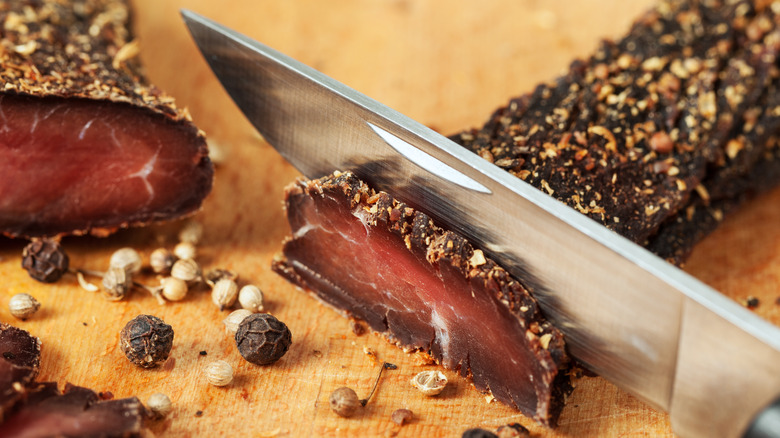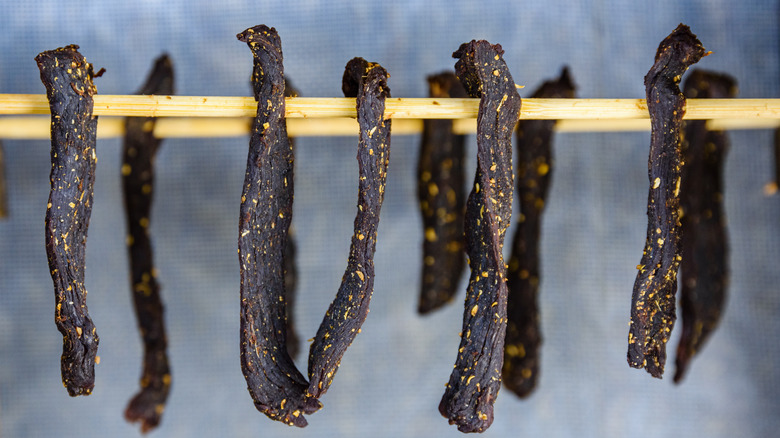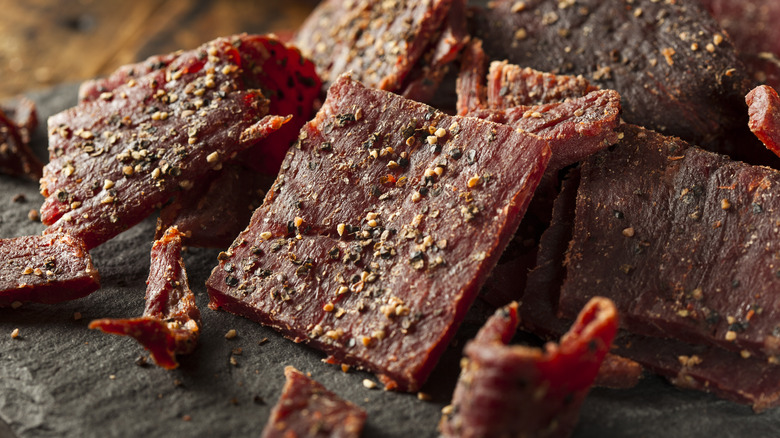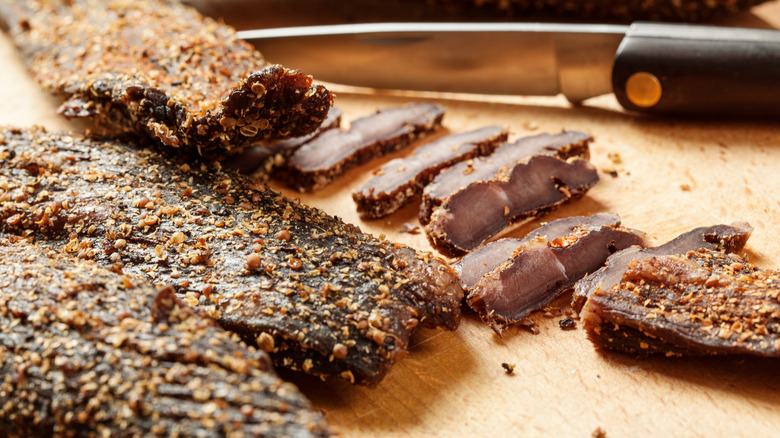The Key Difference Between Biltong And Beef Jerky
Few snacks offer densely-packed satiation quite like dried meat. Take the ever-popular beef jerky: It's high in protein and other nutrients and has been a way of preserving precious meat for centuries. Its long shelf life and dry composition have made it a brilliant snack for travelers from across history.
In the U.S., many renditions other than beef fall under the jerky umbrella, from pork to elk, even including fungi jerky. Abroad, many jerky-style options exist, from Thailand's dried pork snack, moo dad deaw, to Mexico's shredded beef machaca, but Southern Africa has a stand-out example in biltong. This dried meat originated from several countries in the region, and, although it would be easy to mistake it for U.S. jerky, biltong is prepared in a particular way, giving it a distinctive flavor, taste, and composition. It's now becoming increasingly popular in international markets, too. So do add it to your snack drawer. But first, let's discover what makes it different from the beef jerky commonly found on American shelves.
What is biltong?
Biltong is a dried meat product that hails from Africa. It's been consumed in the area around South Africa, including the neighboring countries of Zimbabwe and Botswana, since the early 1600s. Beef is the most common protein source, but like with jerky, various meat types can be turned into biltong. Common ones include venison, kudu, springbok, and ostrich, with fish versions being less standard.
Biltong employs a vinegar and salt base, both for flavoring and curing processes. Then, for additional aroma, it's filled out with spices that vary with different producers, but may well include coriander, cloves, curry, black pepper, and chilies. The food's flavor often fuses Malay tastes, which are commonly utilized in South Africa.
Unlike jerky, biltong relies on a completely air-dried process, which lends it a meatier consistency. Biltong is found in varying textures, ranging from still moist to crisper meats, depending on how long it's cured and dried for. As a result, it encompasses a considerable range of variations.
What is beef jerky?
Beef jerky emerged from a multitude of techniques used in the Americas since pre-Columbian times. Its name hails from a Quechan word, ch'arki, which means dried and salted meat. In addition to preparation in the Northern Andes, similar dried meat recipes were also crafted by Native Americans in North America. Although recipes varied in their protein base – llama, buffalo, and elk were all used — none were crafted with beef in the early days. Cows only arrived in the Americas with the Spanish.
For over a century after the colonial arrival, the technique was referred to as charqui. The first anglicized reference to the word jerky occurred in 1612 in Virginia. Settlers fused centuries-old techniques with newly arrived cattle. Later, the popularity of cowboys further embedded it into American culture.
Today, beef jerky comes in all sorts of flavors and styles. From teriyaki to chipotle, coffee, and bourbon, the food has taken on a dizzying amount of flavors. Yet, at its core, beef jerky is most usually noted for its smokey taste, thinner slices, and sweet notes. And its key distinction is in the preparation process — external heat is utilized. Let's dive into the details.
Beef jerky needs external heat, while biltong is air-dried
The two dried meats exhibit differences in the way they are made. Biltong is a cured, and naturally air-dried product. To dry the meat, it's simply hung in the air for several days, somewhere between 5 and 10, depending on the climate, situation, and what result the maker is looking for. Indoors, the food can be home-dried using a box with fans, lightbulbs, and other homemade contraptions — but of course, different producers have their own processes.
Conversely, beef jerky is a much quicker-to-make dried product, which lends it a different texture. It's manufactured using a dehydrator or other external heat source, which is kept at a lower temperature. Unlike the prolonged production of biltong, jerky can be made in only three hours, utilizing a more dehydrating process. Plus, the meat product is oftentimes smoked at the same time. However, not all jerky is cured, although much of it does spend time in a marinade, just like biltong. Varying techniques, paired with unique flavorings, result in differing outcomes.
Biltong boasts a meatier, more aromatic flavor
Although both biltong and beef jerky can be made with an expansive selection of seasonings applied as a marinade before drying, the two meat products lean to distinct palates. Biltong employs vinegar for curing, a principal difference that leads to a more tangy taste. Its less dehydrated consistency preserves a more traditionally meaty flavor, complemented by a chewier mouthfeel with more fat content, and it's made without any sugar.
Conversely, jerky relies more heavily on salt and sugar for preservation, as well as heat-induced caramelization. Plus, the meat is usually infused with a smokey flavor, which can come from traditional wood smoking, or sometimes from additives. This part is absent when making biltong. Jerky also has a more brittle, cracked consistency that's accentuated by the thinner slices into which it's usually cut.
While beef jerky's popularity has created flavors with far-reaching inspiration, classic recipes always boast a salty undertone, with notes of sugar and smoke. On the other hand, biltong has a much bolder, spiced flavor palate. However, in both styles, there's an abundance of variation based on the producer, which makes trying a new variety of both an adventure, until you find the one that's just right for your palate.




